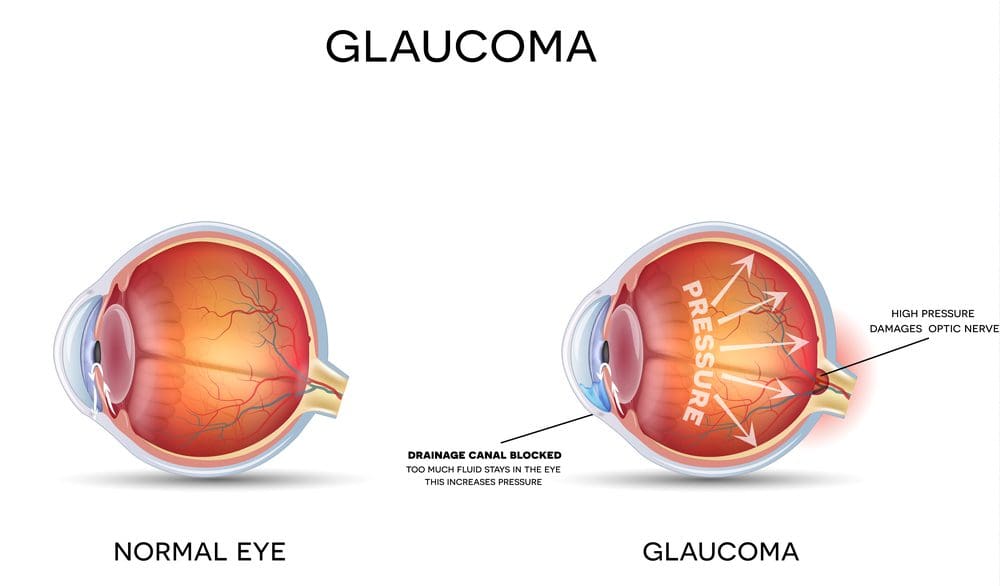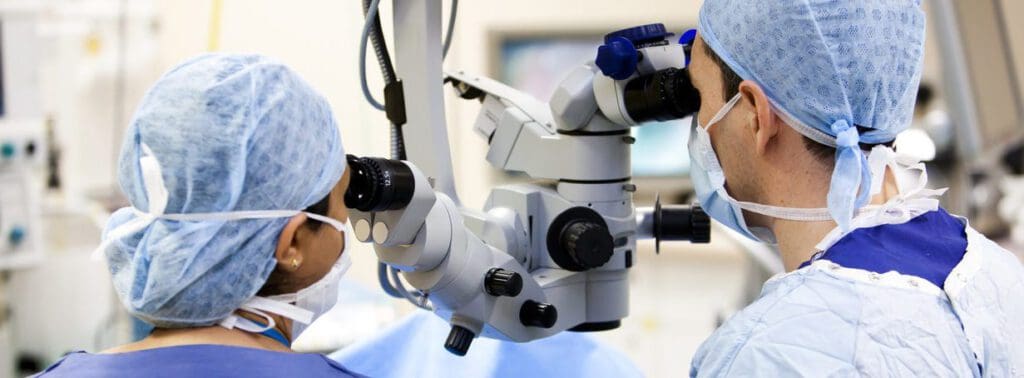SLT Laser for Glaucoma Therapy: Pros, Cons, & More
Last Updated:
If eye drops and oral medications are not successfully lowering the eye pressure, a doctor might discuss selective laser trabeculoplasty (SLT) with the patient. This can also be used as the first treatment for glaucoma. When it is used as an initial treatment, it reduces the intraocular pressure by approximately 30 percent.
Table of Contents
If eye drops and oral medications are not successfully lowering the eye pressure, a doctor might discuss selective laser trabeculoplasty (SLT) with the patient. This can also be used as the first treatment for glaucoma. When it is used as an initial treatment, it reduces the intraocular pressure by approximately 30 percent.
Other research shows that this treatment is effective about 80 percent of the time. This study reported a 20 to 25 percent reduction in intraocular pressure.
Glaucoma remains the leading cause of blindness in the United States. Though there are treatment options, this condition is not curable.
SLT laser therapy is one treatment option for glaucoma. This laser promotes better eye drainage to reduce intraocular pressure.
It is estimated that over 3 million people in the U.S. have glaucoma. Since this potentially debilitating eye condition can lead to blindness, it is imperative to understand the available treatment options.
SLT laser therapy is a treatment people might not be aware of. If you have glaucoma, especially if you haven’t been responding to conventional treatments, talk to your doctor about this option.

What Is Glaucoma?
Over 120,000 people in the U.S. are blind as a result of glaucoma. This condition is characterized by optic nerve damage that typically results from intraocular pressure in the eye being too high. Glaucoma most often occurs in older adults, but people of all ages can be affected.
There are several types of glaucoma, but open-angle glaucoma is the most common. This type is characterized by pressure in the eye increasing due to aqueous fluid draining too slowly. Other types of glaucoma include:
You deserve clear vision. We can help.
With 135+ locations and over 2.5 million procedures performed, our board-certified eye surgeons deliver results you can trust. Your journey to better vision starts here.
- Angle-closure glaucoma. This type affects people of Native American and Asian descent more than those from other ethnic groups. It occurs as a result of a blockage of the eye’s drainage system.
- Normal-tension glaucoma. This type does not involve high pressure, but it is a type of open-angle glaucoma. People with this type have normal pressure levels, but they are especially sensitive to the normal pressure.
- Secondary glaucoma. This type of glaucoma occurs as a result of another eye disease or problem, such as trauma, a tumor, or inflammation.
People can develop this condition in one or both of their eyes. The open-angle type often begins with no symptoms. The person’s vision remains normal, and they experience no pain.
As the condition progresses, the person’s peripheral vision starts to worsen. Eventually, it may feel like they are looking through a tunnel. Without treatment, central vision can reduce until they no longer have any vision.
Any vision loss a person experiences cannot be restored. There are treatments that may help to slow down the progression of this condition though.
Prescription eye drops are usually the first course of treatment. There are several types that patients can discuss with their doctor.
- Prostaglandins reduce eye pressure by increasing the flow of fluid from the eye.
- Alpha-adrenergic agonists increase eye fluid outflow and reduce eye fluid production.
- Beta blockers lower eye pressure by decreasing eye fluid production.
- Rho kinase inhibitors suppresses the enzymes (rho kinase) that cause eye fluid increases to reduce eye pressure.
- Carbonic anhydrase inhibitors reduce eye fluid production.
- Cholinergic or miotic agents increase the amount of fluid flowing from the eye.
If eye drops are not enough, the doctor may prescribe oral medications. The most commonly prescribed type is carbonic anhydrase inhibitors.
There are also surgical procedures if eye drops and oral medications are not successful. These include laser therapies, inserting drainage tubes, filtering surgery, and minimally invasive glaucoma surgery.
When to Consider SLT Laser Treatment

If eye drops and oral medications are not successfully lowering the eye pressure, a doctor might discuss selective laser trabeculoplasty (SLT) with the patient. This can also be used as the first treatment for glaucoma. When it is used as an initial treatment, it reduces the intraocular pressure by approximately 30 percent.
Other research shows that this treatment is effective about 80 percent of the time. This study reported a 20 to 25 percent reduction in intraocular pressure.
This treatment can be used for secondary and primary open-angle glaucoma. Some doctors try eye drops first to reduce intraocular pressure. Other doctors are willing to give SLT a try first. The better option ultimately depends on the individual and their needs.
If compliance with eye drops is a concern, SLT might be considered as an initial treatment. When someone is using eye drops for glaucoma, they need to apply them daily. In some cases, they have to be applied more than once per day. Some studies have concluded that people with glaucoma only use their eye drops about half as often as they should.
Not administering eye drops properly is another concern. Improper use can reduce the efficacy of the medication.
With SLT, compliance is 100 percent. People with glaucoma do not have to administer medicine daily to reap the benefits.
What Is SLT Laser Treatment for Glaucoma?

Before agreeing to SLT, it is important for people to know what it is and how it works. People should also be aware of the possible risks, so they can be prepared if they do occur.
In the U.S. and other countries throughout the world, SLT has been used for over 25 years, so it is not a new treatment option for glaucoma. The purpose of this treatment is to reduce intraocular pressure in the eye of a person with glaucoma.
During SLT, the doctor directs laser energy to the eye’s drainage tissue. This initiates a biological and chemical change in the tissue. This results in fluid draining better, so it is not accumulating in the eye. As excess fluid drains from the eye, it causes intraocular pressure to decrease. It can take approximately one to three months for the results to become apparent.
If one treatment does not lower the intraocular pressure enough, SLT can be repeated. This is because the laser used for the procedure does not burn. The effects can also wear off, so the person may need to have SLT repeated to maintain control over their intraocular pressure. On average, the results of this procedure last for one to five years.
Possible Complications
It is rare for people to experience complications after undergoing SLT, but side effects are possible.
People may experience very mild inflammation after the procedure. To reduce inflammation, doctors often prescribe ibuprofen or another nonsteroidal anti-inflammatory drug.
Transient increased intraocular pressure is possible after SLT. This typically only lasts for a short time. The doctor can prescribe topical medications to control the temporary increase in eye pressure. This side effect typically goes away within about 24 hours following SLT.
Following this procedure, people who were taking glaucoma medications may still need to take them. Other people will be able to control their intraocular pressure with SLT alone. Regular visits with the doctor will determine if medication is warranted.
You deserve clear vision. We can help.
With 135+ locations and over 2.5 million procedures performed, our board-certified eye surgeons deliver results you can trust. Your journey to better vision starts here.
An Option for Some
People with glaucoma who are not getting enough out of their current treatment regimen can speak to their doctor about SLT laser therapy. It may be a more effective option to control their intraocular pressure.
How Much Does SLT Laser Treatment Cost?
SLT is a relatively cost-effective primary therapy for people with glaucoma compared to medication and surgery. One of the earliest cost studies indicated that the cost of bilateral SLT was $675 and a single-eye procedure costing $330. The study was conducted in 2012, and the cost has increased since, as expected.
A 2017 cost comparison put the cost of bilateral SLT treatment at around $840. Today, however, according to MDsave, the estimated national average cost is around $2,000. Cost Helper estimates laser treatment for glaucoma to cost between $1,000 and $2,000. Note that these costs do not include the initial consultation and diagnosis as well as any glaucoma medications.
SLT Frequently Asked Questions (FAQs)
Who is a candidate for SLT?
You’re eligible for SLT if you have primary or secondary open-angle glaucoma and need to lower your IOP. Your ophthalmologist will determine your eligibility following the initial consultation and diagnosis.
How long does SLT treatment last?
SLT treatment is considered highly effective and will lower your internal eye pressure by approximately 30 percent. Initial primary therapy has a success rate between 60 percent and 70 percent. The treatment generally lasts between one to five years and longer than that in some cases.
What happens when it wears off?
Doctors will repeat SLT treatment if the initial surgery wears off after several years. However, subsequent treatments may or may not lower your eye pressure as effectively as the first treatment.
If the first SLT treatment is unsuccessful, repeat procedures will most likely not be effective. If the effect of SLT wears off, glaucoma medications may be a viable option.
What are other alternative laser treatments?
Procedures similar to SLT include micro-pulse laser trabeculoplasty (MLT) and argon laser trabeculoplasty (ALT). ALT employs thermal laser and exhibits higher chances of tissue scarring, therefore, limiting its repeatability.
MLT delivers less energy to your ocular tissue and thus exhibits lower tissue scarring and is repeatable. MLT and SLT have comparable results and potential benefits.
Will I still need glaucoma medication?
The need for medication depends on the patient. For some patients, SLT treatment is sufficient to lower internal eye pressure. Other patients may require additional glaucoma medications to reduce their IOP.
You deserve clear vision. We can help.
With 135+ locations and over 2.5 million procedures performed, our board-certified eye surgeons deliver results you can trust. Your journey to better vision starts here.
References
- Glaucoma: Facts and Figures. Bright Focus Foundation.
- Glaucoma Facts and Statistics. Glaucoma Research Foundation.
- What Are the Different Types of Glaucoma? Prevent Blindness.
- Facts About Glaucoma. National Eye Institute.
- Glaucoma. Mayo Clinic.
- Selective Laser Trabeculoplasty: 10 Commonly Asked Questions. Glaucoma Research Foundation.
- SLT or Drops? Take Your Pick. American Academy of Ophthalmology.
- Treating With SLT First: The Pros and Cons. Review of Ophthalmology.
- Laser Procedures for Glaucoma. Bright Focus Foundation.
- Cost-comparison of two trabecular micro-bypass stents versus selective laser trabeculoplasty or medications only for intraocular pressure control for patients with open-angle glaucoma. (July 2017). National Center for Biotechnology Information.
- Cost of Selective Laser Trabeculoplasty vs Topical Medications for Glaucoma. (April 2012). JAMA Ophthalmology.
- Efficacy and Safety of Selective Laser Trabeculoplasty among Ethiopian Glaucoma Patients. (September 2020). Journal of Ophthalmology.
- Laser Trabeculoplasty ALT, SLT, MLT for Glaucoma. (June 2015). New Glaucoma Treatments.
- Selective laser trabeculoplasty for glaucoma: can it wear off? (March 2020). Top Doctors.
This content is for informational purposes only. It may have been reviewed by a licensed physician, but is not intended to serve as a substitute for professional medical advice. Always consult your healthcare provider with any health concerns. For more, read our Privacy Policy and Editorial Policy.